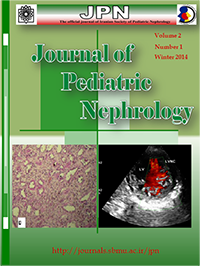Frequency of Massive Proteinuria in Childhood Pyelonephritis and the Response to Antibiotic Therapy
Journal of Pediatric Nephrology,
Vol. 2 No. 1 (2014),
31 January 2014
,
Page 35-38
https://doi.org/10.22037/jpn.v2i1.5667
Abstract
Introduction: Urinary tract infection (UTI) is one of the most common bacterial infections in childhood which can contribute to high blood pressure and renal failure later in life. There are diffident methods for evaluation of a child with UTI for differentiation of cystitis from acute pyelonephritis. One of which is measuring protein in urine. The aim of this study is to investigate the role of UTI in provoking proteinuria.
Material and Methods: This is Quasi- experimental study, before and after, in patients with acute pyelonephritis in Mofid Children's Hospital during 2004-2006. All pyelonephritic patients were treated by intravenous ceftriaxone for at least for 10 days. Random urine samples were taken from all patients at the onset of admission before starting the antibiotic and at the ninth day of treatment for the evaluation of urine protein and creatinine.
Results: 152 children between 1 to 2 years of age entered the study. The prevalence of proteinuria in the acute phase of pyelonephritis was 94.8%. According to our study the prevalence of proteinuria during pyelonephritis is higher in children less than 2 years old (97.3%) and 20% of patients showed nephrotic range of proteinuria. In all cases random urine samples were normal after completion of treatment (p<0.005).
Conclusions: the results of this study illustrate that proteinuria has a high frequency during UTI and acute pyelonephritis. Proteinuria during pyelonephritis may be massive and in the nephrotic range but should not be the cause of concern because in the majority of cases it disappears following treatment.
Keywords: Pyelonephritis; Proteinuria; Antibiotics; Child.
How to Cite
References
Bensman A, Dunand O, Ulinski T. Urinary tract infection, In: Ellis D Avner, William E Harmon. Pediatric Nephrology. Elsevier,2009, 6th ed: 1299-1310.
Zoller G, Wiedemann G, Kallerhof M. Microproteinuria and enzymuria in fever in pyelonephritis in childhood. Urologe Ausg, 1997;36(1):68-76.
Linne T, Fituri O, Escobar R. Functional Parameters and DMSA scan in pyelonephritis. Ped Nephrol, 1994;8(6):694-9.
Mathaii J, Ramaswamy M. Urinalysis in urinary tract infection. Indian J of Pediatric, 1995; 62(6):713-6.
Vaden SL, Pressler BM, Lappin MR, Jensen WA. Effects of urinary tract inflammation and sample blood contamination on urine albumin and total protein concentration in canine urine samples. Vet Clin Pathol, 2004;33(1):14-9.
Hernandez C and Simo R. Albumin Excretion Rate Is Not Affected by Asymptomatic Urinary Tract Infection. Diabetes Care, 2004;27:1565-1569.
Simerville JA, MaxtedWe, PahiraJJ. Urinalysis a comprehensive review. Am Fam Physician, 2005;71:1153-62.
Carter JL, Tomson Ch RV, Stevens PE. Dose urinary tract infection cause proteinuria or microalbuminuria? A systematic review. Nephrology Dialysis Transplantation,2006;21(11):3031-3037.
Muhammad H, Reinold OB, Gans M. Massive proteinuria in a patient with chronic pyelonephritis. Nephrol Dial Transplant, 2000;15:922.
Kwak Ok Byung, Chung S, kim KS. Micro Albuminuria in children with urinary tract infection. Korean J Pediatr. 2010;53(9):840-844.
Yilmaz FM and Yucel D. Effect of addition of hemolysate on urine and cerebrospinal fluid assays for protein. Clin Chem, 2006;52:152-153.
Chiou YY, Chiu NT, Chen MJ, Cheng HL. Role of beta 2-microglobulinuria and microalbuminuria in pediatric febrile urinary tract infection. Acta Paediatr Taiwan, 2001;45:84-89.
Vaden SL, Pressler BM, Lappin MR, Jensen WA. Effects of urinary tract inflammation and sample blood contamination on urine albumin and total protein concentrations in canine urine samples. Vet Clin Pathol, 2004; 33:14-19.
Baskar V, Kamalakannan D, Holland MR, Catchpole CR, Singh BM. Uncertain clinical utility of contemporary strategies for microalbuminuria testing. Diabetes Obes Metab, 2003;5:262-266.
- Abstract Viewed: 387 times
- PDF Downloaded: 103 times

